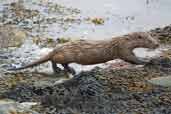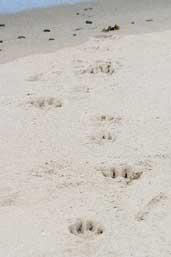
May 2004
The Otter is distributed throughout most of Eurasia south of the tundra and in North Africa. They normally inhabit inland rivers and lochs but those on Shetland and around the Scottish coat have adapted to life on the sea-shore. They are not, however, sea-otters Enhydra lutra which live off the north Pacific coast and are fully adapted to life at sea.

They feed mainly on fish which are caught just off-shore usually amongst dense fringes of seaweed.
Tips on otter-watching to be found at the excellent museum at the Old Haa, Burravoe, Yell include: Don't sit in one spot waiting, just keep moving and keep your eyes open; always try to stay down-wind; look for Great Black-backed Gulls on the shore as they often hang around otters to scavange any left-overs.
| Previous Page | Back to Index | Next Page |